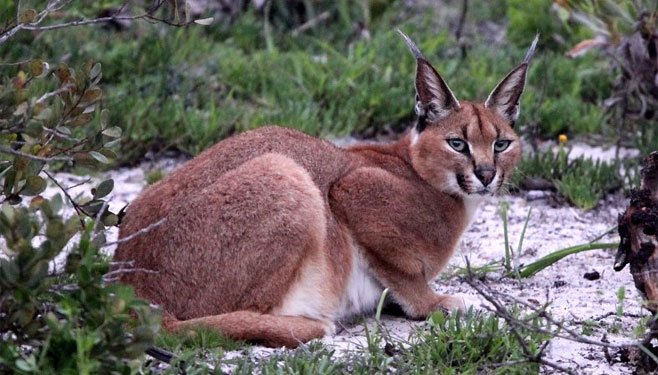|
Caracal caracal (Caracal)
Desert lynx [English]; Rooikat, Lynx [Afrikaans]; Wiistenluchs, Karakal [German]; caracal [French]; simba mangu [Swahili]; indabutshe, intwane [isiNdebele];
ingqawa, ngada [isiXhosa]; indabushe [isiZulu]; thwane [Setswana]; hwang, twana
[Shona]; nandani [Xitsonga]; thwani [Tshivenda]; twani [Lozi]; shilizabula [Yei];
!Hab, IApa Ihôab [Nama, Damara]
Life
>
Eukaryotes >
Opisthokonta >
Metazoa (animals) > Bilateria > Deuterostomia >
Chordata > Craniata > Vertebrata (vertebrates) >
Gnathostomata (jawed vertebrates) > Teleostomi (teleost
fish) > Osteichthyes (bony fish) > Class:
Sarcopterygii (lobe-finned fish) > Stegocephalia
(terrestrial vertebrates) > Reptiliomorpha > Amniota >
Synapsida (mammal-like reptiles) > Therapsida > Theriodontia
> Cynodontia > Mammalia (mammals)
> Placentalia (placental mammals) > Laurasiatheria
> Ferungulata > Ferae > Carnivora > Family:
Felidae (cats) > Subfamily: Felinae
 |
|
Caracal, West Coast National Park, South Africa. [photo Coke
Smith
©] |
 |
|
Caracal on the prowl, Kalahari Desert, South
Africa. [photo
Callie de Wet ©] |
Caracals occur from Africa through to India and
occupy a wide range of habitats. They are solitary in habit except
when mating or the mother is accompanied by young. Prey includes
mammals up to the size of bushbuck, as well as birds and reptiles.
They are considered vermin by farmers because they attack livestock.
Identification
The name caracal is derived from the Turkish
for “black ear”, as its most recognizable features are its pointed
tufted black ears and striking facial markings. One of the larger of
the small cats, it has as stocky body shape and the hind quarters
are higher than the shoulders. The coat is thick with short
reddish–fawn to brick red fur (the Afrikaans name rooikat is very
descriptive). The tail is shortish and quite thick. The back of the
ears are black and the facial markings consist of clear black and
white patches around the eyes and mouth. The canine teeth are heavy
and sharp, well adapted with powerful muscles to deliver a killing
bite. The shearing blades of the carnassials (large shearing
premolar teeth) slice the meat into pieces. There are no grinding
teeth as the food is swallowed with no chewing.
Distribution and habitat
Widespread and numerous in the southern
African subregion but absent from some parts of KwaZulu-Natal and along the Namibian
coast. It occurs widely throughout the rest of Africa and extend
into the Middle East and as far as India. It occupies a wide range of habitats, from
semi-desert to savanna woodland. Also found in hilly country and
coastal forests.
Size
Height at shoulder 40 - 45 cm; weight
range 7 - 19 kg.
Dental Formula
I C C P P =
24 or I =
24 or I C C P P M M =
30 (the presence of molars and an additional upper premolar
is variable). =
30 (the presence of molars and an additional upper premolar
is variable).
General behaviour
A secretive animal that is active mainly at
night (nocturnal) and shelters during the day in thickets, rock
shelters or holes. They also climb trees and lie among the branches.
The caracal is a quiet animal, but purrs when content and hisses,
growls and spits when threatened or alarmed.
Hunting and food
Caracal are very agile hunters and can leap in
the air to catch birds, such as guinea fowl, on the wing. Prey
animals range from mice to antelope the size of bushbuck. They also
eat reptiles. They hunt
by stalking their prey and getting as close as possible before
pouncing on it or chasing it in a short fast pursuit. Remarkable
powers of concealment can hide them in very sparse cover. The attack
is very fast and prey is killed either by a bite to the throat or
the nape of the neck.
Reproduction
Typical of most cats, they are solitary except
when mating or mothers are accompanied by young. The gestation
period is about 79 days. Kittens are born once a
year, with an average litter containing 1-3 kittens. The young are
born in summer in a lair amongst boulders, thick bushes or disused
aardvark burrows. They remain with their mother for 10 months before
dispersing to other areas.
Conservation
Caracal have few natural predators, except man. Hunted and trapped
in small stock farming areas, it is considered vermin – as it
catches sheep and goats. Currently not regarded as threatened but in
the future is in danger of losing suitable habitat due to human
activities, building, farming, etc.
Links
Text by Denise Hamerton |
